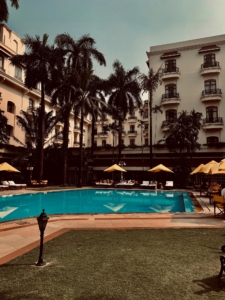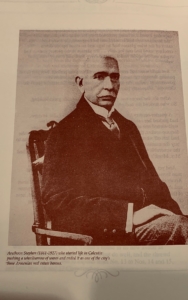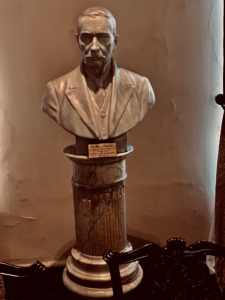When in Kolkata…, or Hotels and Armenians
Sebouh David Aslanian
November 27, 2019
 When in Kolkata to conduct research on the Armenians in India, what better place to lodge at than a historic hotel established by one of your subjects? In addition to being comfortable and luxurious, the Oberoi Grand Hotel also has the advantage of being close and equidistant from the two places where I will work most during my stay: The Armenian Church of Holy Nazareth in Barabazar area of Central Calcutta and the West Bengal State Archives. It is also a stone’s throw from the legendary Armenian College (the Armenian Philanthropic College Մարդասիրական Ճեմարան) which was my first stop yesterday morning after doing some readings and enjoying the childhood sounds of the cooing of doves and cawing of crows at the poolside area of the Hotel. Calcutta this time of the year is very reminiscent of my childhood in Ethiopia. The hotel, whose lush grounds with a pool are a kind of sanctuary for doves, eagles, the ubiquitous crow, hawks whose distinct shrill sounds resemble a celestial horse’s neigh that I remember from my childhood in Ethiopia, and a variety of exotic birds, was first established by a stern and gaunt Armenian from New Julfa, Mr. Arathoon Stephen (1861-1927). Having arrived in Calcutta as a young man with barely a hundred rupees in his pocket, the young Arathoon at first hardly eked out a living by selling wares, including jewelry, from his wheelbarrow. In 1894, he became involved with the Theater Royal on Chowringhee Road and transformed the theater in 1911 into a luxury Hotel aptly named the “Grand Hotel.” One would never think of Armenians as hoteliers, at least this wouldn’t be my first free association with the word Armenian. Merchant, jeweler, banker, dragoman, yes. Hotelier doesn’t seem to roll off the tongue as a trait that Armenians are known for even if hospitality is a stereotypical national trait. At least, not until one realizes that some of the big names in the hotel and entertainment industry in the colonial era are intimately connected with diasporic Armenians. Consider the Baron Hotel
When in Kolkata to conduct research on the Armenians in India, what better place to lodge at than a historic hotel established by one of your subjects? In addition to being comfortable and luxurious, the Oberoi Grand Hotel also has the advantage of being close and equidistant from the two places where I will work most during my stay: The Armenian Church of Holy Nazareth in Barabazar area of Central Calcutta and the West Bengal State Archives. It is also a stone’s throw from the legendary Armenian College (the Armenian Philanthropic College Մարդասիրական Ճեմարան) which was my first stop yesterday morning after doing some readings and enjoying the childhood sounds of the cooing of doves and cawing of crows at the poolside area of the Hotel. Calcutta this time of the year is very reminiscent of my childhood in Ethiopia. The hotel, whose lush grounds with a pool are a kind of sanctuary for doves, eagles, the ubiquitous crow, hawks whose distinct shrill sounds resemble a celestial horse’s neigh that I remember from my childhood in Ethiopia, and a variety of exotic birds, was first established by a stern and gaunt Armenian from New Julfa, Mr. Arathoon Stephen (1861-1927). Having arrived in Calcutta as a young man with barely a hundred rupees in his pocket, the young Arathoon at first hardly eked out a living by selling wares, including jewelry, from his wheelbarrow. In 1894, he became involved with the Theater Royal on Chowringhee Road and transformed the theater in 1911 into a luxury Hotel aptly named the “Grand Hotel.” One would never think of Armenians as hoteliers, at least this wouldn’t be my first free association with the word Armenian. Merchant, jeweler, banker, dragoman, yes. Hotelier doesn’t seem to roll off the tongue as a trait that Armenians are known for even if hospitality is a stereotypical national trait. At least, not until one realizes that some of the big names in the hotel and entertainment industry in the colonial era are intimately connected with diasporic Armenians. Consider the Baron Hotel  established in Aleppo by the Mazloumian brothers around 1870. The great granddaughter of one of the founders was my first doctoral student at UCLA. The Raffles hotel, still a luxury establishment in Singapore was also established by the Armenian Sarkies brothers originally from Julfa in 1887. The Grand Hotel stands in this elite category of hospitality for the rich and powerful. Under the deft competence of its founder Mr. Arathoon, the jeweler and wheelbarrow salesman, the Grand combined its owner’s two talents of offering hospitality to the steam-shipping (the closet equivalent of the modern jet setting) elite of the colonial era with the knack for knowing a good real estate investment when he saw one. Soon after checking in a couple of days ago, I was accompanied by one of the hotel’s extremely professional staff to the grand tearoom on the first floor where a marble bust of the founder is on display. Mr. Arathoon went on not only to become a successful hotelier but also one of Calcutta’s most important real estate developers credited with some landmark buildings, including Stephens house, and Queens mansion and do on. Two of Calcutta’s other important developers were also Armenian including the J.C. Galstaun with whom Arathoon was once associated, I think. After Arathoon’s death in 1927, a local businessman and real estate developer Mohan Singh Oberoi reopened the hotel in 1939 and owned it after 1943. Though arguably the best hotel in Kolkata, the Oberoi Grand is yours for the stay at a modest cost roughly equivalent to the price it takes to lodge at a Comfort Inn in the US.
established in Aleppo by the Mazloumian brothers around 1870. The great granddaughter of one of the founders was my first doctoral student at UCLA. The Raffles hotel, still a luxury establishment in Singapore was also established by the Armenian Sarkies brothers originally from Julfa in 1887. The Grand Hotel stands in this elite category of hospitality for the rich and powerful. Under the deft competence of its founder Mr. Arathoon, the jeweler and wheelbarrow salesman, the Grand combined its owner’s two talents of offering hospitality to the steam-shipping (the closet equivalent of the modern jet setting) elite of the colonial era with the knack for knowing a good real estate investment when he saw one. Soon after checking in a couple of days ago, I was accompanied by one of the hotel’s extremely professional staff to the grand tearoom on the first floor where a marble bust of the founder is on display. Mr. Arathoon went on not only to become a successful hotelier but also one of Calcutta’s most important real estate developers credited with some landmark buildings, including Stephens house, and Queens mansion and do on. Two of Calcutta’s other important developers were also Armenian including the J.C. Galstaun with whom Arathoon was once associated, I think. After Arathoon’s death in 1927, a local businessman and real estate developer Mohan Singh Oberoi reopened the hotel in 1939 and owned it after 1943. Though arguably the best hotel in Kolkata, the Oberoi Grand is yours for the stay at a modest cost roughly equivalent to the price it takes to lodge at a Comfort Inn in the US.
After enjoying the lush oasis of the Oberoi Grand’s poolside area yesterday, I headed out to work at the famed Armenian College on Mirza Ghalib Street and to meet the very reverend Father Movses Galstyan, the pastor and manager of this diasporan landmark of higher education. Father Movses has been incredibly hospitable to me and generous with his time. Founded in 1821 through the generous patronage of two of Calcutta’s wealthy and far-sighted merchants, Mnatsakan Vardon (Vardan) and Astuatsatur Mooratkhanian, the College is now home to over sixty-eight students mostly from Armenia but also from a  strange quilt work of places like Rangoon (Yangon), Baghdad, Isfahan, and even Moscow. Never really in my orbit of interest as a professional historian specializing in early modern history (c. 1500- 1800), the College nevertheless has its genealogy in the early modern period for a number of reasons. First, Calcutta’s Armenian community really began to first flourish in the eighteenth century, even though the community’s earliest documented traces go back to the founding of the city in 1690 by Job Charnock, and some even say predates it. Though there were at least two private schools run by Armenians for their children in the late eighteenth century, the first community-wide institution of higher learning was opened as a result of pooling the resources of the local Armenian merchants and establishing the Philanthropic College in 1821. Second, like the two other places of Armenian higher learning in the nineteenth century, namely the Moorat-Raphael College (or Collegio Armeno of Venice) and the Lazarev Institute of Saint Petersburg, the Armenian College of Calcutta was also established by diaspora patronage networks and merchant capital raised by the most sophisticated elements of the diaspora. I am referring here, of course, to the merchants from New Julfa. I will end my first daily post here since I need to go back to research work at the College.
strange quilt work of places like Rangoon (Yangon), Baghdad, Isfahan, and even Moscow. Never really in my orbit of interest as a professional historian specializing in early modern history (c. 1500- 1800), the College nevertheless has its genealogy in the early modern period for a number of reasons. First, Calcutta’s Armenian community really began to first flourish in the eighteenth century, even though the community’s earliest documented traces go back to the founding of the city in 1690 by Job Charnock, and some even say predates it. Though there were at least two private schools run by Armenians for their children in the late eighteenth century, the first community-wide institution of higher learning was opened as a result of pooling the resources of the local Armenian merchants and establishing the Philanthropic College in 1821. Second, like the two other places of Armenian higher learning in the nineteenth century, namely the Moorat-Raphael College (or Collegio Armeno of Venice) and the Lazarev Institute of Saint Petersburg, the Armenian College of Calcutta was also established by diaspora patronage networks and merchant capital raised by the most sophisticated elements of the diaspora. I am referring here, of course, to the merchants from New Julfa. I will end my first daily post here since I need to go back to research work at the College.




